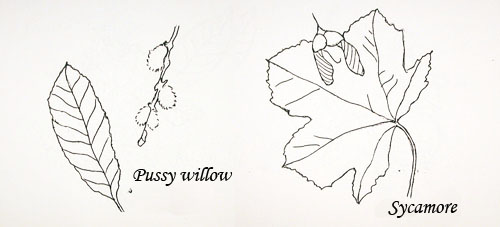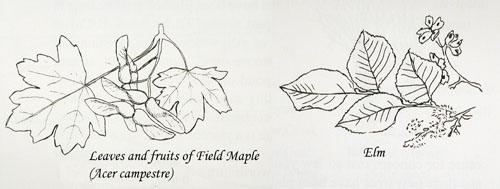
TREES, WOODLANDS AND HEDGES
(Back to Chapter 4 Index)
The parish of Sulgrave has never within the last 300-400 years been densely wooded, and there exist only a few mature woods of small area, none of them particularly ancient. They are:
1. Fox Covert: about four acres, mainly of beech, ash and oak, with a few birch and occasional sycamore and holly.
2. Great Ground Covert: about one acre, nearly all oak.
3. Great Ground Spinney: ash, oak, field maple, about two thirds of an acre.
4. A small spinney: about half an acre of sitka spruce, with some ash, oak.
See here for the location of these woodlands.
Trees have been planted at some time in the past around Glebe Pond - a mix of ash, willow, horse chestnut and sycamore - and, more recently, around the pond off the Weston Road, including oak, holly, rowan, hornbeam, sweet chestnut and Japanese crab apple. There is a planted shelter belt of oak and ash, with some hybrid poplar, near the Culworth turn off the Moreton Pinkney Road.
Within the last twenty years, however, several other pieces of land have been planted with mixed largely native trees, mainly broadleaf; in time, these will make a valuable contribution to wildlife and landscape. They are as follows:
Location A, 1972: Six acres of oak, Scots pine, gean (wild cherry), with also Norway spruce, Douglas fir, turkey oak.
Location B, 1974: Three acres of oak, cherry, European larch, with som Lawson's cypress as shelter.
Location C, 1981: One acre of oak, cherry, ash, beech.
Locations D1 and D2, 1988: Two areas of wetland planted with alder, dogwood, goat willow, with some walnut, about one and a half acres.
Location E, 1988: Three quarters of an acre, including oak, cherry, holly, gorse and wild service tree.
Locations F1 and F2, 1990: Two pieces of about five acres and two and a half acres, consisting of 65% oak, 25% beech and 10% of other species - sweet chestnut, cherry, lime, hornbeam, wild service and holly.
Location G, 1992: A strip of land, some 200 yards long and 20 feet wide, alongside the Weston Road, planted with oak, ash, field maple and hazel.
The locations of these more recent plantings can be seen here.
In the absence of large woods, the trees of the hedgerows and fields assume greater importance in the landscape. Apart from hawthorn, the commonest hedging material used in the enclosure of land, the great majority of these trees were not planted by man, but grew from naturally sown seeds or from suckers, and therefore the variety of species is not as wide as in plantations such as those above. Generally speaking, the more species of tree or shrub in a hedge, the older the hedge. Within this parish the commonest hedgerow tree by far is the ash, followed by the oak and then species of willow (crack willow and white willow), the latter being found most often along watercourses. A survey carried out in 1988-89 of all trees of 20 feet in height or more produced these figures:
| Ash | 978 | 67.3% |
| Oak | 228 | 15.6% |
| Willow | 152 | 10.4% |
| Sycamore | 31 | 2.1% |
| Field Maple | 17 | 1.2% |
| Elm | 10 | 0.7% |
| Hawthorn | 9 | 0.6% |
| Crab Apple | 7 | 0.5% |

The remainder consisted of planted species such as poplar, horse chestnut, larch, beech and scots pine. The ash outnumbers other species in all parts of the parish except the south-eastern section, where the oak predominates; these two together with species of willow account for some 93% of all hedgerow and open-field trees. Tragically, the English elm, which would have been such a prominent feature until some 25 years ago, has now disappeared as a mature tree, thanks to elm disease. A few dead specimins still stand, but there are many elm suckers in the hedges, some of which have reached 20 feet and more; it remains to be seen whether any will survive to maturity. The field maple is also common in hedgerows (as in the location shown here) but is seldom allowed to grow to any height; possibly the best specimin stands by the side of the stream near the Helmdon Road. The existence in a hedge of other small trees such as crab apple, blackthorn, pussy willow and hazel, together with shrubs (dogwood, guelder rose etc) usually indicates that the hedge is older than most of those in the parish. In several places (e.g. in the locations shown here), trees now stand isolated in open fields; presumably they mark the line of vanished field boundaries.
One other native tree is certainly worthy of note; the tallest tree and the only one of its 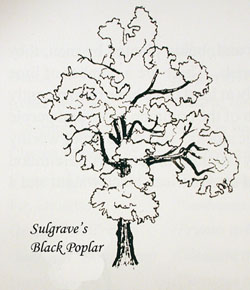 species in the parish is a magnificent black poplar (for location see here), planted in the 1870s, and now, alas, showing signs of advancing old age. Of non-natives, the sycamore, probably introduced into Britain in Tudor times, has naturalised readily; there are a number of fine mature specimins, such as the one in the village by the Thatched House Hotel. A prolific self-seeder, the species has commonly established itself in hedges. Mention must be made of the trees which have sprung up naturally along the strip of the former Great Central Railway line since its closure in 1966, mainly ash, oak and hawthorn, but with a few birch - possibly seedlings from those in Fox Covert. This is a demonstration of the fact that uncultivated, unsprayed, ungrazed land will in the course of time revert to forest. Here is a valuable refuge for wild flowers and wildlife in general.
species in the parish is a magnificent black poplar (for location see here), planted in the 1870s, and now, alas, showing signs of advancing old age. Of non-natives, the sycamore, probably introduced into Britain in Tudor times, has naturalised readily; there are a number of fine mature specimins, such as the one in the village by the Thatched House Hotel. A prolific self-seeder, the species has commonly established itself in hedges. Mention must be made of the trees which have sprung up naturally along the strip of the former Great Central Railway line since its closure in 1966, mainly ash, oak and hawthorn, but with a few birch - possibly seedlings from those in Fox Covert. This is a demonstration of the fact that uncultivated, unsprayed, ungrazed land will in the course of time revert to forest. Here is a valuable refuge for wild flowers and wildlife in general.
A number of ash and willow trees have been pollarded in time past; the system was to cut off all branches at a height of 8 feet - 15 feet, at intervals. As the trees quickly sprouted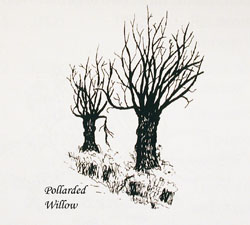 new branches, this provided a regular source of wood for fuel, fencing and other purposes. Examples may still be seen off the Helmdon Road (see map). Many of the older trees in the parish are "stag-headed", that is, some of their topmost and outermost branches are dead. Die-back of this kind does not necessarily mean that the tree itself is dying; often it will throw out new healthy branches from lower down, and oaks in particular may live on for many years after reaching this stage. However, it is obvious that many of the ashes are nearing the end of their days, and it is a cause for concern that so few young trees are growing on to take their place. Here and there new trees have been planted, sometimes in the hedge itself - for example, a few including wild cherry and lime along the west side of the Helmdon Road - but a more effective (and cheaper!) method is simply to allow already existing saplings to grow to maturity. Current hedge-trimming practice resents the extra time required to avoid these, but the alternative in the not-distant future is a landscape virtually without the characteristically British hedgerow trees.
new branches, this provided a regular source of wood for fuel, fencing and other purposes. Examples may still be seen off the Helmdon Road (see map). Many of the older trees in the parish are "stag-headed", that is, some of their topmost and outermost branches are dead. Die-back of this kind does not necessarily mean that the tree itself is dying; often it will throw out new healthy branches from lower down, and oaks in particular may live on for many years after reaching this stage. However, it is obvious that many of the ashes are nearing the end of their days, and it is a cause for concern that so few young trees are growing on to take their place. Here and there new trees have been planted, sometimes in the hedge itself - for example, a few including wild cherry and lime along the west side of the Helmdon Road - but a more effective (and cheaper!) method is simply to allow already existing saplings to grow to maturity. Current hedge-trimming practice resents the extra time required to avoid these, but the alternative in the not-distant future is a landscape virtually without the characteristically British hedgerow trees.
Within the village itself there are many fine trees, and, being planted by man, they include some specimins not found naturally in the parish. There are a number of lime trees, horse chestnut, walnut (although unfortunately at least three have been recently felled as unsafe because of old age) and beech, both of the common green and purple varieties, such as the two overshadowing the village stocks. Individual trees worthy of note include a tall yew, a tulip tree and a mulberry (all three in gardens in Helmdon Road), a fine Lebanese cedar (Sulgrave House) and an American black walnut and a gleditsia or honey locust (both Sulgrave Manor).
List of trees and shrubs which may be regarded as "native" to this parish:
| Ash (Fraxinus excelsior) | Hawthorn, Common (Crataegus monogyna) |
| Birch (Betulus pendulus) | Hawthorn, Midland (Cataegus laevigata) |
| Blackthorn (Prunus spinosa) | Hazel (Corylus avellana) |
| Crab apple (Malus sylvestris) | Holly (Ilex aquifolium) |
| Dogwood (Cornus sanguinea) | Oak (Quercus robur) |
| Elder (Sambucus nigra) | Spindle (Euonymus europaeus) |
| Elm (Ulmus procera) | Sycamore (Acer pseudoplatanus) |
| Field Maple (Acer campestre) | Willow, Crack (Salix fragilis) |
| Gorse (Ulex europaeus) | Willow, Goat (Salix carprea) |
| Guelder Rose (Viburnum opulus) | Willow, White (Salix alba) |
Other trees (some of which were originally native here) which have been planted within the parish:
| Alder (Alnus glutinosa) | Pear (Pyrus communis) |
| Beech (Fagus sylvatica) | Pine, Scots (Pinus sylvestris) |
| Cedar, lebanese (Cedrus libana) | Poplar, Black (Populus nigra betulifolia) |
| Chestnut, Horse (Aesculus hippocastanum) | Polar, Hybrid (Populus deltoides) |
| Chestnut, Sweet (Castanea sativa) | Rowan (Sorbus aucuparia) |
| Cypress, Lawsons (Chamaecyparis lawsoniana | Spruce, Norway (Picea abies) |
| Fir, Douglas ((Pseudotsuga menziesii) | Spruce, Sitka (Picea sitchensis) |
| Gean/Wild Cherry (Prunus avium) | Tulip Tree (Liriodendron tulipifera) |
| Gleditsia or Honey Locust (Gleditsia triacanthos) | Walnut, Black (Juglans nigra) |
| Hornbeam (Carpinus betulus) | Walnut, Common (Juglans regia) |
| Larch, European (Larix decidua) | Whitebeam, Common (Sorbus aria) |
| Lime, Common/European (Tiliax vulgaris) | Whitebeam, Swedish (Sorbus intermedia) |
| Lime, Broad-leaved (Tilia platyphyllos) | Wild Service Tree (Sorbus torminalis) |
| Lime, Small-leaved (Tilia cordata) | Willow, Cricket-bat (Salix alba caerulea) |
| Mulberry (Morus nigra) | Yew (Taxus baccata) |
| Oak, Turkey (Quercus cerris) |
HEDGES
A fifth of the ancient boundary and post-enclosure hedgerows in England have been lost over the past six years, vanishing at the rate of 4000 miles a year, due to either neglect or deliberate removal. The term 'post-enclosure hedge' refers to hedges planted about the time of the Enclosures Act of 1761, which changed the Sulgrave landscape quite significantly. Hedges remaining from before that time are 'ancient boundary hedges'.
Sulgrave has certainly not lost a fifth of its hedgerows. However, if those that are now neglected and sparse in growth are added to those that have actually been pulled up, it is probably that by the end of the decade that figure will be true of the parish.
Some 85% of Sulgrave hedges that are 'managed' are simply sheared each year, and many of these hedges, quite apart from looking unattractive whilst recovering from the crude slashing of the branches, are now becoming overgrown with elder which would seem to thrive on this drastic 'pruning'.
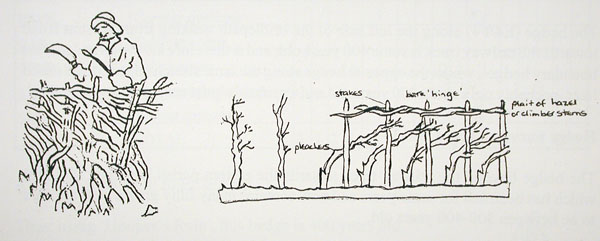
There have been some recently cut and laid hedges made from previously overgrown or neglected stretches - a good cut and laid hedge, with annual pruning will only need re-laying about every twenty years. As it takes at least two hours to tackle one yard of hedge, it is fortuitous that the Government now offer some grant aid towards hedge laying, but as this by no means fully covers the cost, it is likely that the machine cutter will continue to rule.
A detailed survey has been made of four hedges in the parish in order to attempt to date them.
The widely used 'Hooper's rule' is based on observations made by Dr Max Hooper in the early 1970s regarding the species of tree and shrub found and the age of some 227 hedges, 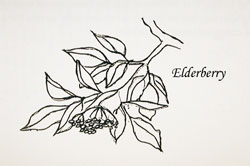 which when checked against accurate written records showed an unexpected degree of correlation between the two.
which when checked against accurate written records showed an unexpected degree of correlation between the two.
As a rule of thumb, the number of different species (excluding brambles, honeysuckle, ivy and other undershrubs or woody climbers) counted in a 30 yard length of hedge is approximately equal to the age of the hedge in centuries. A single 30 yard length however could give totally misleading results, so an average of at least eight consecutive lengths have been surveyed with an 'average' result being formed.
The four hedges surveyed in Sulgrave showed interesting results:
Hedge Survey Records Nos. 1 & 2
The hedge (see here) along the left side of the bridlepath walking from Weston Road towards the railway track is some 400 years old, and is therefore known as an 'ancient boundary hedge', whilst the opposite hedge along the same stretch appears to be much later - probably only about 200 years old and a probable 'post enclosure award hedge'.
Hedge Survey Record No. 3
The hedge beyond the railway track towards the eastern parish boundary (see here) which has been left for some years and now contains many fully grown trees appears to be between 300-400 years old.
Hedge Survey Record No. 4
The oldest and most interesting hedge is the parish boundary hedge following the public footpath from Stutchbury Gate to the Greatworth Road beyond Wemyss Farm (see here). This hedge, which by Hooper's Rule is at least 500 years old, includes species which offer a virtual larder of fruits, nuts and berries for both birds and humans alike.
HEDGE SURVEY RECORD NO. 1
Location: Left hand side of bridle path from Weston Road (see here). Date: September 1991
The numbers 01 to 17 refer to 30 yard lengths.
| 01 | 02 | 03 | 04 | 05 | 06 | 07 | 08 | 09 | 10 | 11 | 12 | 13 | 14 | 15 | 16 | 17 | ||
| ASH | Fraxinus excelsior | * | * | * | ||||||||||||||
| CRAB APPLE | Malus sylvestris | * | ||||||||||||||||
| DOGROSE | Rosa canina | * | * | * | * | * | * | |||||||||||
| DOGWOOD | Cornus sanguinea | * | * | * | * | |||||||||||||
| ELDER | Sambucus nigra | * | * | * | * | * | * | * | * | * | * | |||||||
| ELM | Ulmus procera | * | * | * | * | * | * | |||||||||||
| FIELD MAPLE | Acer campestre | * | * | * | ||||||||||||||
| GUELDER ROSE | Viburnum opulus | * | * | |||||||||||||||
| HAWTHORN | Crataegus monogyna | * | * | * | * | * | * | * | * | * | * | * | * | * | * | |||
| HAZEL | Corylus avellana | * | * | |||||||||||||||
| OAK | Quercus robur | |||||||||||||||||
| PUSSY WILLOW | Salix caprea | |||||||||||||||||
| SYCAMORE | Acer pseudoplatanus | * | ||||||||||||||||
| SLOE | Prunus spinosa | * | * | * | * | * | * | * | ||||||||||
| TOTAL | 3 | 3 | 2 | 3 | 3 | 5 | 1 | 6 | 4 | 3 | 5 | 4 | 3 | 4 | 3 | 2 | 5 |
AVERAGE NO. OF SPECIES: 4
Thus, using 'Hooper's Rule', this hedge is 400 years old.
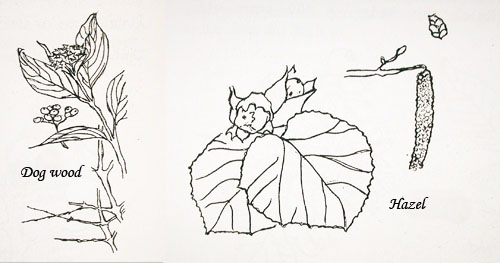
HEDGE SURVEY RECORD NO. 2
Location: Returning on bridle path towards Weston Road, left hand side. Date: September 1991.
The numbers 01 to 17 refer to 30 yard lengths.
| 01 | 02 | 03 | 04 | 05 | 06 | 07 | 08 | 09 | 10 | 11 | 12 | 13 | 14 | 15 | 16 | 17 | ||
| ASH | Fraxinus excelsior | * | * | * | * | * | * | * | ||||||||||
| CRAB APPLE | Malus sylvestris | |||||||||||||||||
| DOGROSE | Rosa canina | |||||||||||||||||
| DOGWOOD | Cornus sanguinea | |||||||||||||||||
| ELDER | Sambucus nigra | * | * | * | * | * | ||||||||||||
| ELM | Ulmus procera | * | * | * | * | * | * | * | * | * | ||||||||
| FIELD MAPLE | Acer campestre | * | ||||||||||||||||
| GUELDER ROSE | Viburnum opulus | |||||||||||||||||
| HAWTHORN | Crataegus monogyna | * | * | * | * | * | * | * | ||||||||||
| HAZEL | Corylus avellana | |||||||||||||||||
| OAK | Quercus robur | |||||||||||||||||
| PUSSY WILLOW | Salix caprea | |||||||||||||||||
| SYCAMORE | Acer pseudoplatanus | |||||||||||||||||
| SLOE | Prunus spinosa | * | * | * | * | |||||||||||||
| TOTAL | 3 | 4 | 1 | 1 | 1 | 1 | 3 | 4 | 2 | 2 | 2 | 1 | 1 | 2 | 2 | 2 | 1 |
AVERAGE NO. OF SPECIES: 2
Thus, using 'Hooper's Rule', this hedge is 200 years old.
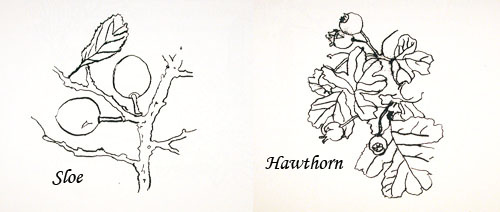
HEDGE SURVEY RECORD NO. 3
Location: Going east on bridle path beyond railway track to parish boundary. Date: September 1991.
The numbers 01 to 18 refer to 30 yard lengths.
| 01 | 02 | 03 | 04 | 05 | 06 | 07 | 08 | 09 | 10 | 11 | 12 | 13 | 14 | 15 | 16 | 17 | 18 | ||
| ASH | Fraxinus excelsior | * | * | * | * | * | * | * | * | ||||||||||
| CRAB APPLE | Malus sylvestris | * | * | * | |||||||||||||||
| DOGROSE | Rosa canina | * | * | * | |||||||||||||||
| DOGWOOD | Cornus sanguinea | ||||||||||||||||||
| ELDER | Sambucus nigra | * | * | * | * | * | * | ||||||||||||
| ELM | Ulmus procera | ||||||||||||||||||
| FIELD MAPLE | Acer campestre | * | * | * | * | * | |||||||||||||
| GUELDER ROSE | Viburnum opulus | ||||||||||||||||||
| HAWTHORN | Crataegus monogyna | * | * | * | * | * | * | * | * | * | * | * | * | * | * | * | |||
| HAZEL | Corylus avellana | * | |||||||||||||||||
| OAK | Quercus robur | * | * | * | * | * | * | ||||||||||||
| PUSSY WILLOW | Salix caprea | ||||||||||||||||||
| SYCAMORE | Acer pseudoplatanus | ||||||||||||||||||
| SLOE | Prunus spinosa | * | * | * | * | * | * | * | * | * | |||||||||
| TOTAL | 2 | 2 | 1 | 1 | 2 | 1 | 3 | 4 | 4 | 4 | 4 | 4 | 4 | 3 | 2 | 6 | 4 | 5 |
AVERAGE NO. OF SPECIES: 3
Thus, using 'Hooper's Rule', this hedge is 300 years old, although the last 330 yards could be 400 years old - there is a distinct 'change' in the hedge at a field boundary, so it is likely that this is so.
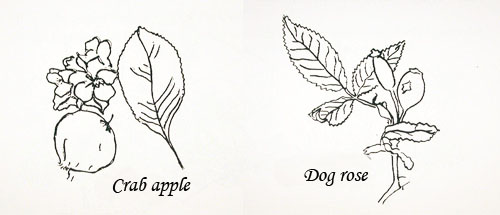
HEDGE SURVEY RECORD NO. 4
Location: Parish boundary hedge (south) - see here. Date: September 1991.
The numbers 01 to 17 refer to 30 yard lengths.
| 01 | 02 | 03 | 04 | 05 | 06 | 07 | 08 | 09 | 10 | 11 | 12 | 13 | 14 | 15 | 16 | 17 | ||
| ASH | Fraxinus excelsior | * | ||||||||||||||||
| CRAB APPLE | Malus sylvestris | * | * | |||||||||||||||
| DOGROSE | Rosa canina | * | ||||||||||||||||
| DOGWOOD | Cornus sanguinea | * | ||||||||||||||||
| ELDER | Sambucus nigra | * | * | * | * | * | * | * | * | |||||||||
| ELM | Ulmus procera | * | * | |||||||||||||||
| FIELD MAPLE | Acer campestre | * | * | |||||||||||||||
| GUELDER ROSE | Viburnum opulus | |||||||||||||||||
| HAWTHORN | Crataegus monogyna | * | * | * | * | * | ||||||||||||
| HAZEL | Corylus avellana | * | * | * | ||||||||||||||
| OAK | Quercus robur | |||||||||||||||||
| PUSSY WILLOW | Salix caprea | * | ||||||||||||||||
| SYCAMORE | Acer pseudoplatanus | * | * | * | * | * | * | * | * | |||||||||
| SLOE | Prunus spinosa | * | ||||||||||||||||
| TOTAL | 2 | 7 | 7 | 2 | 6 | 6 | 6 | 4 |
AVERAGE NO. OF SPECIES: 5
Thus, using 'Hooper's Rule', this hedge is 500 years old
